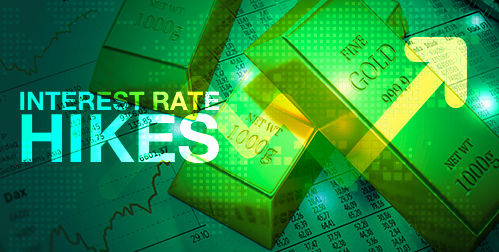The Relationship Between Interest Rates and Gold Prices
There is a widely held belief that when the Federal Reserve raises interest rates, the price of gold always goes down. This may seem like the case because rising interest rates improve the returns on fixed income investments like bonds and money market funds. Since gold does not yield interest, investors move their money from it into the higher yielding investments. However, there is no definitive evidence that gold prices must go down when rates go up.
There is no guaranteed inverse relationship between interest rates and gold prices. Gold is traded on a global market and the Federal Reserve is just one part of a much larger picture.
Historical data proves this out. There was a massive bull market in gold during the 1970s. Gold hits its highest price of the 20th century during that period while interest rates were high and quickly rising. Short term interest rates went from 3.5% in 1971 to 16% by 1980. Meanwhile, gold rose from under $50 an ounce to nearly $850 an ounce during those years. Gold prices increased alongside interest rates. Conversely, a bear gold market began in the 1980s as interest rates were getting lower.
Gold prices and interest rates have also moved opposite each other in the past. There was a gold bull market in the 2000s. During this time interest rates declined. But even this doesn’t prove low interest rates spur gold prices. Gold prices peaked far in advance of the largest interest rate cuts. In addition, from 2004 to 2006, the federal funds rate climbed from 1% to 5%. During these same years, gold increased in value by almost 50%.1
There can appear to be a connection based on which set of data you look at. But connection is not causation. The price of gold is not determined by interest rates. Instead, it
is ultimately determined by supply and demand on a global scale. Demand is the stronger influence. Supply changes slowly because it takes a long time to discover and bring new gold to market.
The largest buyers of gold today exist outside the sphere of the Federal Reserve. In Russia, China and India, gold demand is surging. They are seeking a stable alternative to the US dollar. Bloomberg reported that global central banks are now buying the most gold since the U.S. abandoned the gold standard in 1971. The figures for 2019 dipped just modestly from 2018’s 50-year record.2
Interest Rates Have Greater Effect on Stocks Than Gold
The stock market is more sensitive to interest rates than gold. Recent rate increases have sent markets plummeting. Sell offs occur because traders fear high interest rates will lead to shrinking profits and recession. Investors turn to gold when interest rates rise because they want to preserve their wealth as stocks decline.
The value of the US dollar does impact gold. Gold is usually denominated in U.S. dollars. Its price can fluctuate as the value of the dollar rises and falls. If the dollar goes up, the price of gold goes down, because you can now buy a larger amount of gold with each dollar than before. What’s more, when the U.S. dollar drops, investors look for alternative investment sources to store value. Gold is the leading alternative. This drives the price of gold up.
During this time of record interest rate hikes, it may appear that the Fed will dramatically push down the price of gold. Yet, raising interest rates are more likely to sink the stock market and cause a recession. Demand for gold will continue as investors flee securities for safe haven assets. If you are interested in preserving your wealth during this economic downturn, then you should consider a Gold IRA. Contact us today to learn more.







